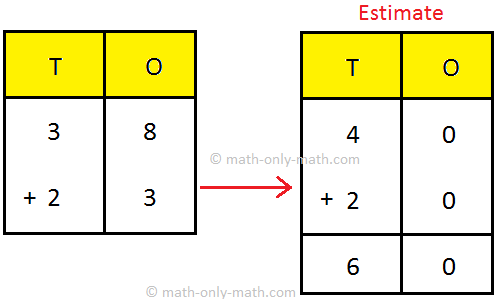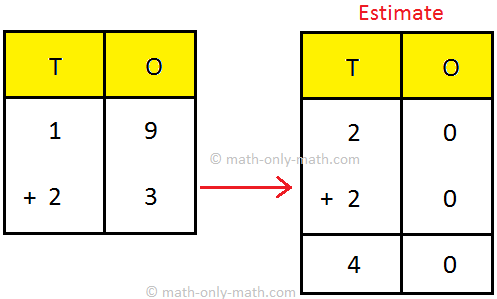Subscribe to our YouTube channel for the latest videos, updates, and tips.
We will learn the basic knowledge for
estimating a sum. Here we will learn an easy way to estimate a sum of two
numbers by rounding.
In case of two digit numbers we can only round
the number to the nearest tens place i.e. only one place estimate.
For example, let us estimate the following sums:
(i) 47 + 32
We need to round the number to the nearest 10.
47 → 50
32 → 30
50 + 30 = 80
(ii) 25 + 34
We need to round the number to the nearest 10.
25 → 30
34 → 30
30 + 30 = 60
(iii) 75 + 13
We need to round the number to the nearest 10.
75 → 80
13 → 10
80 + 10 = 90
To estimate the sum we round-off each number to the nearest tens and then add the rounded-off numbers.
Let us estimate 38 + 23.
38 is nearer to 40 than 30.
So, 38 is rounded up to 40.
The number 23 is nearer to 20 than 30.
So, 23 is rounded down to 20.
Estimate the Sum to the Nearest 10 Video
Subscribe to our YouTube channel for the latest videos, updates, and tips.
Solved Examples on Estimating the Sum:
1. Estimate the sums of 72 and 48
Solution:
We round the number to the nearest 10.
72 → 70
48 → 50
So, 72 is nearest to 70 and 48 is
nearest to 50
70 + 50 = 120
Thus
the estimated sum = 120
2. Estimate the sums to the nearest ten and also find the actual sum
of 87 and 79.
Solution:
We round the number to the nearest 10.
87 → 90
79 → 80
So, 87 is nearest to 90 and 79 is
nearest to 80
90 + 80 = 170
Thus
the estimated sum = 170
The actual sum of 87 and 79
87 + 79 = 166
Thus
the actual sum = 166
Note: To estimate to the nearest 10,
we see the digit/number at one’s place. It is converted to 0 or 10 as proper.
If the digit/number is
10/2, it is converted to 10.
Estimating the Sum of 3-Digit Numbers:
In case of three digit numbers we can only
round the number to the nearest tens place i.e. only one place estimate.
For example, let us estimate the following
sums:
1. Estimate the sums of 586 and 120
Solution:
We round the number to the nearest
hundred.
586 → 600
120 → 100
So, 586 is nearest to hundred is 600 and
120 is nearest to hundred 100
600 + 100 = 700
Thus
the estimated sum to nearest hundred = 700
We round the number to the nearest tens.
586 → 590
120 → 120
So, 586 is nearest to ten is 590 and 120
is nearest to hundred 120
590 + 120 = 710
Thus
the estimated sum to nearest ten = 710
We have learnt rounding off numbers. We can use the rounding off to estimate the sum of two numbers. Rounding off to the nearest ten will result in the estimated answer to be closest to the actual one.
2. Estimate the sum of 415 and 214 to the nearest 10’s.
Solution:
Rounding off the numbers to the nearest 10’s, we get
415 → 420
214 → 210
Now, 420 + 210 = 630
Thus, the estimated sum is 630.
3. Round off the numbers 389 and 535 to the nearest 100s. Find the estimated and the actual sum.
Solution:
Rounding off the numbers to nearest 100s
Hence, 400 + 500 = 900 is the estimated sum.
4. Estimate the sum of 1235 and 1695 to the nearest 100’s.
Solution:
Rounding off the numbers to the nearest 100’s, we get
1235 → 1200
1695 → 1700
Now, 1200 + 1700 = 2900
Thus, the estimated sum is 2900.
In general,
When we add two 2-digit numbers we begin adding from the ones place.
For estimating the sum of two 2-digit numbers, just add the tens place and add ten more. The actual answer may be a little more or a little less, but the difference will never be more than 10. That is a fair estimate.
5. Estimate the sum of 34 and 22.
Solution:
|
30 + 20 = 50 Step II: Add 10 to the sum obtained in step I. 50 + 10 = 60 |
Actual Sum 3 4 + 2 2 5 6 |
Thus, we say that the sum of 34 and 22 is about 60.
6. There are 45 mangoes and 28 oranges in a bag. About how many fruits are there in the bag?
|
Solution: Step I: Add the tens. 4 tens + 2 tens = 6 tens. 40 + 20 = 60 Step II: Add 10 to the sum obtained in step I. 60 + 10 = 70 So, there are about 70 fruits in the bag. |
Actual Sum 4 5 + 2 8 7 3 |
Worksheet on Estimating a Sum:
I. Estimate the sum. One has been done for you.
(i) 19 + 23
(ii) 27 + 44
(iii) 54 + 36
(iv) 41 + 38
(v) 52 + 17
(vi) 26 + 28
Answer:
I. (ii) 30 + 40 = 70
(iii) 50 + 40 = 90
(iv) 40 + 40 = 80
(v) 50 + 20 = 70
(vi) 30 + 30 = 60
II. Round off the given numbers to the nearest 100s. Find the estimated and the actual sum.
|
Estimated Sum |
Actual Sum |
|
|
(i) 582 and 157 |
__________ |
__________ |
|
(ii) 245 and 163 |
__________ |
__________ |
|
(iii) |
__________ |
__________ |
|
(iv) 345 and 198 |
__________ |
__________ |
Answer:
II. (i) 800, 739
(ii) 400, 408
(iii) 900, 923
(iv) 500, 543
III. First find the actual sum and then estimated sum:
Answer:
III. (i) 60; 60
(ii) 80; 90
(iii) 934; 930
(iv) 958; 960
IV. Estimate the sum to the nearest 10’s by first rounding off the numbers:
(i) 348 + 472
(ii) 2651 + 1279
(iii) 1295 + 2365
Answer:
IV. (i) 820
(ii) 3930
(iii) 3670
From Estimating a Sum to HOE PAGE
Didn’t find what you were looking for? Or want to know more information
about Math Only Math.
Use this Google Search to find what you need.














